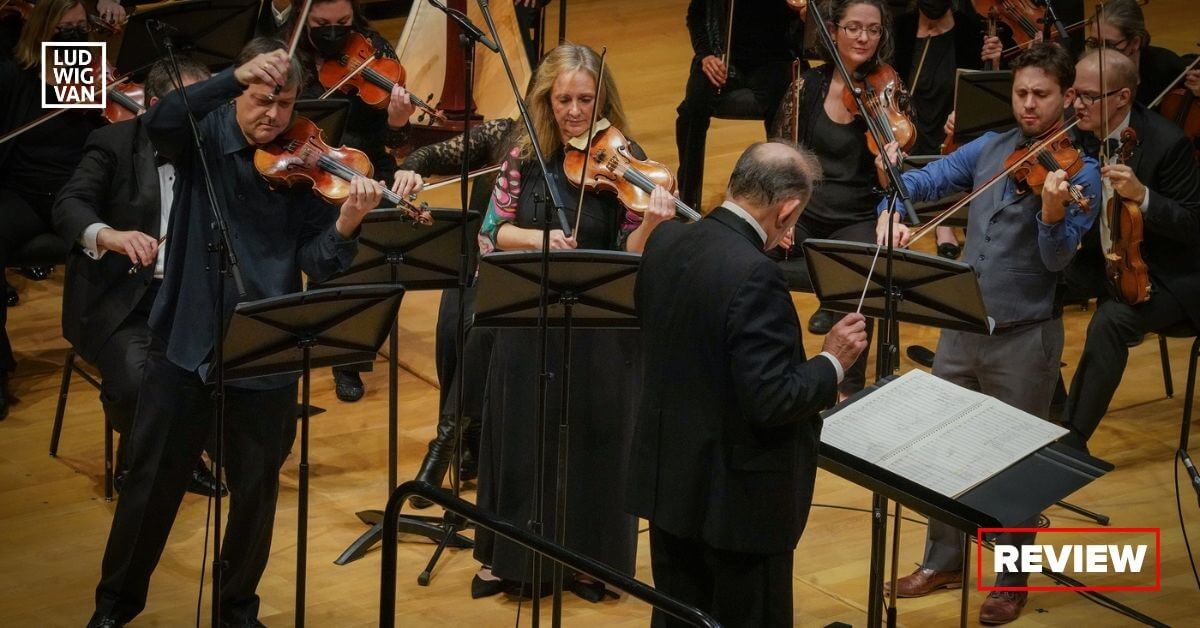
Evangelista: Violinissimo; Staniland: Six Enigmas; Rea: Figures hâtives; Louie: Triple Concerto. Esprit Orchestra, Alex Pauk conducting; Aaron Schwebel, Stephen Sitarski, Marie Bérard, violinists. November 27, 2022, Koerner Hall, Toronto.
In an article in the current issue of The WholeNote magazine, composer Alexina Louie described what she called the “wild idea” behind last night’s Esprit Orchestra concert at Koerner Hall. Credit Louie’s husband, Esprit Music Director Alex Pauk, with the “wild” decision to present three Canadian violin concertos, each featuring a different Toronto concertmaster, before bringing the three soloists together for a performance of Louie’s Triple Concerto for three violins and orchestra.
What’s most important — it worked!
For a concert of contemporary classical music, this one made for surprisingly comfortable listening, eschewing the prolonged stasis or electronically-derived textures too often heard these days, much less the now-obsolescent caustic dissonances of atonality. These pieces were tonal and rhythmically forward-moving, the violinists never required to resort to extended techniques or special effects.
Leading off was José Evangelista’s Violinissimo (1993) with Aaron Schwebel, Concertmaster of the National Ballet of Canada Orchestra. This was the only work on the program in the traditional concerto format of three movements, fast-slow-fast, and it was the least “modern” sounding as well. The opening Acrobatico is a sprightly dance and the concluding Vertiginoso an even more energetic, syncopated folk-dance. But it’s the central Meditazione that stands out. Here, Schwebel sustained an intense, melancholy, lyrical line, at times in the violin’s highest register, over the orchestra’s disjunct, heavily metallic, percussive chords, a haunting highlight of the evening.
Next up was the world premiere of Six Enigmas by Andrew Staniland, commissioned by Esprit, with Esprit Concertmaster Stephen Sitarski as soloist. In his program notes, Staniland wrote of “references/quotes, compositional devices and homage to great works of the past. These little mysteries are embedded throughout the work.” (I confess I failed to recognize any of Staniland’s “references/quotes.”)
In six connected movements, the episodic music features fast, even furious, repeated violin passagework, fortissimo orchestral blasts, restless woodwinds and brass, rippling arpeggios from Esprit pianist Talisa Blackman, a heavily accented section in which the music steadily rises in pitch, volume and velocity, generating real excitement, a lengthy, dreamy passage building to yet another violent outburst, all ending as the violin gently fades over sweetly chiming piano and percussion.
At 14 minutes, John Rea’s Figures hâtives (2006), commissioned by the Montreal Symphony Orchestra, was the shortest work on the program. (The concertos by Evangelista and Staniland clocked in at 19 minutes; Louie’s Triple Concerto at 16 minutes.) It was also the most adventurous — melodically, rhythmically and harmonically. Marie Bérard, Concertmaster of the Canadian Opera Company Orchestra, shared the spotlight with Esprit harpist Sanya Eng, conspicuously positioned in the centre of the stage. It was Eng who began the piece with a six-note phrase that reverberated throughout the work. In his pre-concert comments, Rea described this piece as “shadows chasing each other” and the music is indeed elusive. Its shifting meters, shimmering percussion and disjointed orchestral mutterings, often unrelated to the violin’s busy figurations, make this concerto even more enigmatic than Staniland’s.
Finally, the three concertmasters assembled for Louie’s Triple Concerto (2017), a work jointly commissioned by the Toronto Symphony Orchestra, National Arts Centre Orchestra and Montreal Symphony Orchestra for Canada’s 150th birthday and premiered by the concertmasters of the three orchestras.
In two connected movements, the music reflects Louie’s penchant for glittering, bell-like percussion, continuously tolling throughout the first movement. Marked Tranquillo, it’s in fact quite energized. At one point, each violinist, in turn, became a soloist, playing alone while the other two remained silent. The brief Interlude – Sospirando featured prominent harp arpeggios over gentle percussion, while the final Con veloce e forza – Scintillante ended the concerto and the concert, with an outpouring of jubilation.
In addition to the accessible, colourfully scored concertos, all thrillingly performed by the three soloists and the Esprit Orchestra conducted by Alex Pauk, what made this concert particularly refreshing is that unlike most Canadian works, doomed to be forgotten, often unfairly, after their premieres, the concertos by Evangelista, Rea and Louie evidently continue to have a life after birth. Staniland’s kaleidoscopic Six Enigmas might well become another survivor.
#LUDWIGVAN
Get the daily arts news straight to your inbox.
Sign up for the Ludwig van Daily — classical music and opera in five minutes or less HERE.
- SCRUTINY | 21C Offers Mixed Bag Of New Works - January 23, 2023
- SCRUTINY | Maxim Vengerov Brings Virtuosity With Expression To Koerner Hall - January 16, 2023
- SCRUTINY | Kronos Quartet Showcases Fifty For The Future Project With Three RCM Quartets - December 9, 2022



